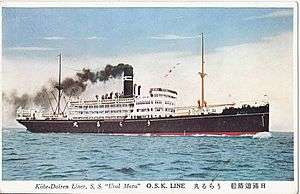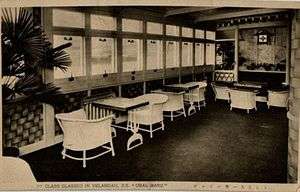SS Ural Maru
 Postcard of Ural Maru in the 1930s | |
| History | |
|---|---|
| Name: | Ural Maru |
| Port of registry: | Japan |
| Builder: | Mitsubishi Nagasaki Shipyards |
| Yard number: | 1-452 |
| Laid down: | 1 May 1928 |
| Launched: | 15 December 1928 |
| Completed: | 30 March 1929 |
| Fate: | sunk, 27 September 1944 |
| General characteristics | |
| Type: |
|
| Tonnage: | 6,375 long tons (6,477 t) |
| Length: | 123.32 m (404.6 ft) p-p |
| Beam: | 16.76 m (55.0 ft) |
| Draught: | 10.05 m (33.0 ft) |
| Propulsion: | steam turbines, 2 screws, 6,658 ihp (4,965 kW) |
| Speed: |
|
| Notes: | Passengers: 65 (1st class), 130 (2nd class), 583 (3rd class) |

Ural Maru (うらる丸 Uraru-Maru) was a 6,374-ton Japanese merchant vessel, used as a transport ship and hospital ship during World War II. She was torpedoed and sunk with the loss of some 2,000 lives on 27 September 1944.
History
Ural Maru was a combined cargo/passenger vessel owned and operated by Osaka Shosen (the predecessor to Mitsui OSK Lines). She was completed in 1929 by the Mitsubishi Nagasaki Shipyards and was in regularly scheduled service between Kobe and Osaka in Japan and the port of Dairen in the Kwantung Leased Territory on the Asian mainland. Ural Maru made her first voyage on 12 April 1929.
Her civilian career was relatively uneventful, although she was damaged in Osaka by a typhoon in 1934 [1]
In 1937, after the start of the Second Sino-Japanese War, Ural Maru was requisitioned by the Imperial Japanese Army and converted into a hospital ship from 13 October 1937 to February 1938, returning sick and wounded soldiers from the front back to Japan.
Ural Maru was briefly returned to commercial service, but was requisitioned again by the Imperial Japanese Army in November 1941, and used primarily as a military transport to carry troops and military supplies from the Army’s primary staging area of Hiroshima in Japan to various ports in southeast Asia, including Saigon, Singapore, the Philippines, Rabaul, Rangoon and Palau in the initial stages of the war. In February 1943, she was converted to a hospital ship again, and was painted white with a large red cross, as per international regulations.
On 3 April 1943, when evacuating 50 wounded soldiers from Guadalcanal, Ural Maru was bombed by USAAF Boeing B-17 Flying Fortress bombers and lightly damaged. She managed to return to Osaka, where the damage was much publicized. [A differing record of the bomber type may be found in the Unit Diary (held in the Australian War Memorial Canberra) of 2/1 Australian Hospital Ship "Manunda". In the diary there is a "Special Report" received 5 April 1943 which stated that a USAAF B-24 (Liberator) bomber from 321st Squadron, 90th Bomber Group, had on 3 April bombed and damaged Hospital Ship "Ural Maru" off New Hanover Island in the Bismark Group (300 km N-W of Rabaul)]. Contemporary Japanese press labeled the attack on a clearly marked hospital ship carrying civilians as a war crime.[2] In response to the Australian protest against the sinking of the hospital ship Centaur, the Japanese had lodged a counter-protest about attacks on, and the sinking of a number of their own hospital ships, including the Ural Maru.
On her last voyage, Ural Maru had departed Singapore bound for Takao in Taiwan and had called on Kuching and Miri in Japanese-occupied Sarawak, where she loaded Japanese wounded, nurses and a number of "comfort women". In addition there were ten unusual passengers – Indian National Army cadets of Indian origin on their way to Japan for military training. Only one of them, Bishan Singh, died in the sinking. One of the survivors, Ramesh S. Benegal, went on to become an officer in the Indian Air Force in independent India and retired as an Air Commodore. He provided a first-person account of the sinking of the Ural Maru in his book "Burma to Japan with Azad Hind - A War Memoir". The complement of passengers is also based on his account.[3]
Ural Maru was torpedoed in the South China Sea and sunk on 27 September 1944 by the American submarine USS Flasher (SS-249) approximinately 240 kilometres (150 mi) west of Luzon at coordinates (15°40′N 117°18′E / 15.667°N 117.300°ECoordinates: 15°40′N 117°18′E / 15.667°N 117.300°E)[4]
As narrated by Ramesh S Benegal in his book, it was around eight in the morning when they were about to start their breakfast, when there was a loud explosion. The uneaten bowls of soup fell over and there was another explosion some distance away from the ship. Then they heard sirens and screaming. He exited hastily to the deck. He saw a thick cloud of smoke billowing from another ship of the convoy about a mile away; but the smoke was so thick that the ship was not visible. The Ural Maru began to list. He was unaware about the extent of damage but soon it was announced on the loudspeakers to prepare to abandon ship. The passengers began to help each other to put on their life jackets.
As the list increased the crew shouted for everyone to abandon the ship immediately. There was a mad scramble for a lifeboat and two or three people got in when it began to be lowered. The list was making things difficult and someone cut the rope and the lifeboat plunged down. It spilled the passengers into the sea and sank. With the lifeboat gone panic stricken passengers near the rails jumped overboard. The ship was now almost vertical and the propellers had come out of the water and were still churning. Many who jumped landed on the propellers or parts of the keel of the ship. A nurse was trying to crawl along the nearly vertical deck when wooden rafts secured at the other end of the deck broke loose and came crashing down on her. Her scream prompted Benegal and his friend Narayanan to jump into the sea. They managed to swim to a wooden raft about eight to ten inches thick and six feet square with rope loops around the sides. This raft had a couple of people aboard, and Benegal and Narayanan joined them to await rescue. He had barely boarded the raft when there was a loud "whoosh" and he turned around and saw the ship half overturn and disappear into the sea. Benegal saw the ship’s captain, the mate and another man standing on the top of the sinking ship. They made no effort to save themselves and went down with the ship
References
- Jordan, Roger W (2006). The World's Merchant Fleets, 1939: The Particulars And Wartime Fates of 6,000 Ships Warship Losses of World War Two. Naval Institute Press. ISBN 1-59114-959-2.
- Earhart, David C. (2008). Certain victory: images of World War II in the Japanese media. ME Sharpe. ISBN 0-7656-1776-5.
- Benegal, Ramesh (2009). Burma to Japan with Azad Hind: A War Memoir 1941–1944. Lancer. ISBN 1-935501-11-9.
External links
- Maritime Disasters of World War II. "Burma to Japan with Azad Hind - A War Memoir" (Lancer Publishers, New Delhi, copyright Meera R. Benegal, 2009).
- Tabular Record of Movement (Japanese)
Notes
- ↑ "JAPAN: Juggernaut of Air". Time. 1 October 1934.
- ↑ Earhart, D.C. (2008). Certain Victory: Images of World War II in the Japanese Media. M.E. Sharpe. p. 364. ISBN 9780765617774. Retrieved 20 August 2015.
- ↑ Benegal; The INA cadets on board the Ural Maru were: (Malayans of Indian parentage) Narayanan, Bishan Singh, Navaratnam, Ghosh, Robert Prosper, Ranjit Das; (Burmese of Indian parentage) Benegal, Gandhi Das, Dutta, Bimol Deb.
- ↑ Jordan
See also
| Wikimedia Commons has media related to SS Ural Maru. |
- List by death toll of ships sunk by submarines
- List of battles and other violent events by death toll
- Hikari Kikan